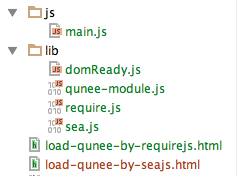RequireJS与SeaJS模块化加载
web应用越变的庞大,模块化越显得重要,尤其Nodejs的流行,Javascript不限用于浏览器,还用于后台或其他场景时,没有Class,没有Package的Javascript语言变得难以管理,于是出现CommonJS项目,提出了一些规范模块化的写法,在Nodejs中普遍应用,同样浏览器端也出现了类似的解决方案,并结合浏览器异步加载的特性,有RequireJS提出的AMD(Asynchronous Module Definition)规范,以及SeaJS提出的CMD(Common Module Definition)规范,两者都实现Javascript了模块化定义的APIs,各有异同,下面将分别使用两种方案,实现Qunee组件的模块化加载
相关文章
关于RequireJS的文章很多,这里重复介绍,列出几篇专业文章:
requireJS官方网站 http://requirejs.org/ SeaJS官方网站 http://seajs.org/ 使用 RequireJS 优化 Web 应用前端 http://www.ibm.com/developerworks/cn/web/1209_shiwei_requirejs/ Javascript模块化编程(一):模块的写法 http://www.ruanyifeng.com/blog/2012/10/javascript_module.html Javascript模块化编程(二):AMD规范 http://www.ruanyifeng.com/blog/2012/10/asynchronous_module_definition.html Relation between CommonJS, AMD and RequireJS? http://stackoverflow.com/questions/16521471/relation-between-commonjs-amd-and-requirejs
模块化定义
两种模块化方式,都使用define来定义模块,所以需要将qunee.js改造成模块化的方式,因为Qunee只有一个全局变量,本身就符合模块化的写法,直接用define包一下就可以了,起名为qunee-module.js 目录结构  lib/qunee-module.js
lib/qunee-module.js
define(function (require, exports, module) {
return function (t, i, e) {
"use strict";
...
}
});
使用requireJS加载模块
<script data-main="main" src="lib/require.js"></script>
<script>
require.config({
baseUrl: 'js',
paths: {
Q: '../lib/qunee-module'
}
});</script>
首先需要引入requireJS,并设置了"data-main"属性为"main",表示入口模块"js/main.js",之所以在./js/目录,是因为后面配置了require,设置了"baseUrl"为"js",表示根目录为"js/",后面配置的paths,也是相对这个目录,paths中相当于设置模块别名,后面可通过别名引入模块
var Q = require("Q");
使用SeaJS加载模块
如果用SeaJS则可以改成下面的代码
<script src="lib/sea.js"></script>
<script>
// seajs 的简单配置
seajs.config({
base: "./js",
alias: {
"Q": "../lib/qunee-module.js"
}
});
// 加载入口模块
seajs.use("main");
</script>
入口模块
入口程序也可以使用define的形式,并通过传入参数"require"来加载模块 比如引入qunee-module.js
var Q = require("Q");
js/main.js
define(function(require) {
var Q = require("Q");
var graph = new Q.Graph("canvas");
var hello = graph.createNode("Hello", -100, -50);
hello.image = Q.Graphs.server;
var qunee = graph.createNode("Qunee", 100, 50);
var edge = graph.createEdge("Hello\\nQunee", hello, qunee);
edge.setStyle(Q.Styles.LABEL_OFFSET_Y, -10);
edge.setStyle(Q.Styles.LABEL_POSITION, Q.Position.CENTER_TOP);
edge.setStyle(Q.Styles.LABEL_ANCHOR_POSITION, Q.Position.CENTER_BOTTOM);
edge.setStyle(Q.Styles.LABEL_BORDER, 1);
edge.setStyle(Q.Styles.LABEL_POINTER, true);
edge.setStyle(Q.Styles.LABEL_PADDING, new Q.Insets(2, 5));
edge.setStyle(Q.Styles.LABEL_BACKGROUND_GRADIENT, Q.Gradient.LINEAR_GRADIENT_VERTICAL);
});
